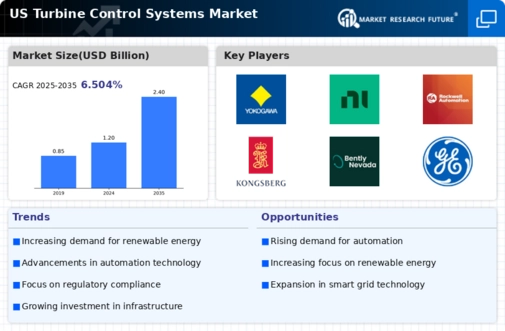The US Turbine Control Systems Market is characterized by significant competition among various players that offer advanced technologies and solutions for optimizing turbine performance and enhancing operational efficiency. The market is driven by the increasing demand for renewable energy sources, the need for improved efficiency in power generation, and the rising need for automation in industrial processes. This competitive landscape features a mix of established companies and emerging players, all striving to innovate and provide state-of-the-art turbine control solutions.
The market is influenced by numerous factors including technological advancements, regulatory policies, and economic trends that dictate the operational capabilities of turbine systems. Understanding the competitive dynamics within this market is essential for stakeholders looking to invest or strategize within this sector.Emerson Electric has a strong presence in the US Turbine Control Systems Market, known for providing innovative solutions that enhance the reliability and efficiency of turbine operations. The company focuses on integrating advanced control systems and instrumentation, harnessing extensive expertise in automation and process control.
Emerson Electric's strengths lie in its ability to develop customized solutions tailored to specific client needs, thereby ensuring optimal turbine performance across various applications. The company also excels in providing ongoing support and maintenance services to clients, solidifying customer loyalty and satisfaction.
With a robust track record in the market, Emerson Electric continues to expand its influence through strategic partnerships and a commitment to innovation, ensuring it remains competitive in the evolving landscape of turbine control systems.Woodward is another key player in the US Turbine Control Systems Market, recognized for its specialized products and comprehensive services designed to enhance turbine performance and reliability. The company provides a diverse range of solutions including control systems, actuators, and fuel systems aimed primarily at the power generation sector.
Woodward’s strengths include advanced technology capabilities and a dedicated approach to customer service, which allows it to create highly efficient and reliable controls for both gas and steam turbines. The company has made significant investments in research and development, focusing on innovative products that meet the growing demands of the energy sector. Woodward's strategic growth has been further enhanced by mergers and acquisitions, which allow the company to broaden its portfolio and expand its market presence in the US.
Through these efforts, Woodward remains a formidable competitor in the turbine control systems market, consistently delivering reliable solutions that address both current and future industry challenges.




















